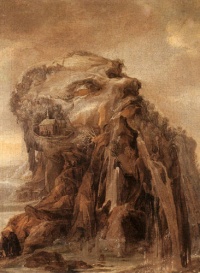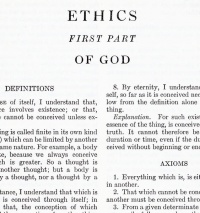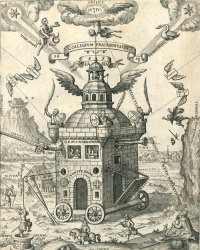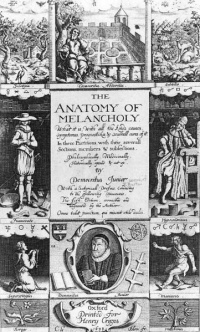17th century
From The Art and Popular Culture Encyclopedia
| Revision as of 16:54, 27 September 2014 Jahsonic (Talk | contribs) ← Previous diff |
Current revision Jahsonic (Talk | contribs) |
||
| Line 1: | Line 1: | ||
| [[Image:The Anatomy of Melancholy by Robert Burton frontispiece 1638 edition.jpg|thumb|left|200px| Frontispiece for the 1638 edition of ''[[The Anatomy of Melancholy]]'' by [[Robert Burton]] ]] | [[Image:The Anatomy of Melancholy by Robert Burton frontispiece 1638 edition.jpg|thumb|left|200px| Frontispiece for the 1638 edition of ''[[The Anatomy of Melancholy]]'' by [[Robert Burton]] ]] | ||
| - | [[Image:Iconologia.jpg|thumb|right|200px|''[[Iconologia]]'' (1593) by [[Cesare Ripa]] was an [[emblem book]] highly influential on [[Baroque]] imagery]] | + | {| class="toccolours" style="float: left; margin-left: 1em; margin-right: 2em; font-size: 85%; background:#c6dbf7; color:black; width:30em; max-width: 40%;" cellspacing="5" |
| - | [[Image:Joos de Momper.jpg|thumb|right|200px|''[[Anthropomorphic]] [[Landscape]]'' (early [[17th century]]) by [[Joos de Momper]]]] | + | | style="text-align: left;" | |
| - | [[Image:Theatre from Ars Memoriae by Robert Fludd.jpg|thumb|right|200px|''[[Ars Memoriae]]'': The [[Theatre]] ([[1619]]) - [[Robert Fludd]]]] | + | "When people in the early [[17th century|seventeenth century]] talk of 'machines' they usually mean [[stage machinery|theatrical machines]]."--''[[Theatre of the World]]'' (1969) by Frances Yates |
| + | <hr> | ||
| + | "If we substitute [[mechanics]] for [[magic]] as the operative force used by the [[Creator]], [[John Dee|Dee]]'s religion was perhaps not altogether unlike that of [[Isaac Newton]]."--''[[Theatre of the World]]'' (1969) by Frances Yates | ||
| + | <hr> | ||
| + | "''[[Nouvelles de la république des lettres]]'' was a [[periodical]] devoted to reviews of current publications, edited and in large part written by [[Pierre Bayle]]. Beginning publication in 1684, it is the first known [[book review]] journal and coined the term "[[Republic of Letters]]"."--Sholem Stein | ||
| + | |} | ||
| + | [[Image:Iconologia.jpg|thumb|right|200px|''[[Iconologia]]'' (1593) by Cesare Ripa was an emblem book highly influential on Baroque imagery]] | ||
| + | [[Image:Joos de Momper.jpg|thumb|right|200px|''[[Anthropomorphic Landscape]]'' (early 17th century) by Joos de Momper]] | ||
| + | [[Image:Theatre from Ars Memoriae by Robert Fludd.jpg|thumb|right|200px|[[Method of loci]]<br><small>Illustration: ''[[Theatrum Orbi]]'' engraving by Johann Theodor de Bry</small>]] | ||
| [[Image:Ethics by Spinoza.jpg|Spinoza's|thumb|right|200px|By virtue of his [[magnum opus]], the posthumous ''[[Ethics (book)|Ethics]]'', [[Spinoza]] is considered one of [[Western philosophy|Western philosophy's]] definitive ethicists.]] | [[Image:Ethics by Spinoza.jpg|Spinoza's|thumb|right|200px|By virtue of his [[magnum opus]], the posthumous ''[[Ethics (book)|Ethics]]'', [[Spinoza]] is considered one of [[Western philosophy|Western philosophy's]] definitive ethicists.]] | ||
| - | [[Image:Diagram of the human mind, from Robert Fludd (1574-1637), Utriusque cosmic maioris scilicet et minoris metaphysica.jpg|thumb|right|200px|''[[Utriusque cosmi maioris scilicet et minoris metaphysica]]'' by [[Robert Fludd]]]] | + | [[Image:Diagram of the human mind, from Robert Fludd (1574-1637), Utriusque cosmic maioris scilicet et minoris metaphysica.jpg|thumb|right|200px|''[[Utriusque cosmi maioris scilicet et minoris metaphysica]]'' by Robert Fludd]] |
| [[Image:Speculum Sophicum Rhodostauroticum.jpg|thumb|right|200px|Illustration to the ''[[Speculum Sophicum Rhodostauroticum]]'' ([[1618]]) by [[Teophilus Schweighardt Constantiens]]]] | [[Image:Speculum Sophicum Rhodostauroticum.jpg|thumb|right|200px|Illustration to the ''[[Speculum Sophicum Rhodostauroticum]]'' ([[1618]]) by [[Teophilus Schweighardt Constantiens]]]] | ||
| {{Template}} | {{Template}} | ||
| - | :''[[17th century art]], [[17th century in literature]], [[Baroque]]'' | + | {|class="toc hlist" id="toc" summary="Contents" style="margin-left:auto; margin-right:auto; text-align:center;" |
| - | + | |colspan="3" | | |
| + | |- | ||
| + | ! style="text-align:right; width:310px;"|<< [[16th century]] | ||
| + | ! style="width:125px;"| | ||
| + | ! style="text-align:left; width:310px;"|[[18th century]] >> | ||
| + | |} | ||
| As a means of recording the passage of [[time]], the '''17th century''' was that [[century]] which lasted from [[1601]]-[[1700]]. | As a means of recording the passage of [[time]], the '''17th century''' was that [[century]] which lasted from [[1601]]-[[1700]]. | ||
| Line 57: | Line 70: | ||
| :''[[17th century music]]'' | :''[[17th century music]]'' | ||
| - | * [[Johann Christoph Bach]], Composer and great-uncle of the genius, ([[1642]]–[[1703]]) | ||
| * [[Johann Sebastian Bach]], German composer of genius ([[1685]]–[[1750]]) | * [[Johann Sebastian Bach]], German composer of genius ([[1685]]–[[1750]]) | ||
| * [[Georg Friedrich Handel]], German Composer ([[1685]]–[[1759]]) | * [[Georg Friedrich Handel]], German Composer ([[1685]]–[[1759]]) | ||
| Line 64: | Line 76: | ||
| * [[Johann Pachelbel]] ([[1653]]–[[1706]]), German composer | * [[Johann Pachelbel]] ([[1653]]–[[1706]]), German composer | ||
| * [[Henry Purcell]], English composer ([[1659]] – [[1695]]) | * [[Henry Purcell]], English composer ([[1659]] – [[1695]]) | ||
| - | * [[Monsieur de Sainte-Colombe]], French composer and the subject of a 1991 film ''[[Tous les matins du monde (film)|Tous les matins du monde]]'' (c. [[1640]] – [[1700]]) | ||
| *[[Antonio Vivaldi]] Italian composer (four seasons concerti) ([[1678]]–[[1741]]) | *[[Antonio Vivaldi]] Italian composer (four seasons concerti) ([[1678]]–[[1741]]) | ||
| Line 91: | Line 102: | ||
| ==See also== | ==See also== | ||
| + | :''[[17th century art]], [[17th century in literature]], [[Baroque]]'' | ||
| *[[17th century science and philosophy]] | *[[17th century science and philosophy]] | ||
| *[[17th century politics]] | *[[17th century politics]] | ||
Current revision
|
"When people in the early seventeenth century talk of 'machines' they usually mean theatrical machines."--Theatre of the World (1969) by Frances Yates "If we substitute mechanics for magic as the operative force used by the Creator, Dee's religion was perhaps not altogether unlike that of Isaac Newton."--Theatre of the World (1969) by Frances Yates "Nouvelles de la république des lettres was a periodical devoted to reviews of current publications, edited and in large part written by Pierre Bayle. Beginning publication in 1684, it is the first known book review journal and coined the term "Republic of Letters"."--Sholem Stein |


,_Utriusque_cosmic_maioris_scilicet_et_minoris_metaphysica.jpg)

|
Related e |
|
Featured: |
| << 16th century | 18th century >> | |
|---|---|---|
As a means of recording the passage of time, the 17th century was that century which lasted from 1601-1700.
The 17th century falls into the Early Modern period of Europe and was characterized by the Baroque cultural movement and the beginning of modern science and philosophy, including the contributions of Galileo Galilei, René Descartes, Blaise Pascal, Isaac Newton; Europe was torn by warfare throughout the century by the Thirty Years' War, while European colonization of the Americas began in earnest.
The year 1600 is hailed by many as the beginning of the era of modern freethought, as it is marked by the execution in Italy of Giordano Bruno by the Holy Inquisition.
Contents |
Significant people
Visual artists
- Peter Paul Rubens, Flemish painter (1577 – 1640)
- Frans Hals (1580–1666)
- Nicolas Poussin, French painter (1594 - 1665)
- José de Ribera, Lo Spagnoletto (1591 – 1652)
- Gian Lorenzo Bernini, Italian sculptor, architect (1598 – 1680)
- Francisco Zurbarán, Spanish Painter (1598 – 1664)
- Francesco Borromini, Italian sculptor, architect (1599–1667)
- Diego Rodríguez de Silva y Velázquez, Spanish painter (1599–1660)
- Rembrandt van Rijn, Dutch painter (1606 – 1669)
- Bartolomé Esteban Murillo, Spanish painter (1617 – 1682)
- Jan Steen (1626–1679)
- Johannes Vermeer, Dutch Painter (1632 – 1675)
Literature
- Félix Lope de Vega, Spanish playwright and poet (1562 – 1635)
- William Shakespeare, English author and poet (1564 – 1616)
- Ben Jonson, English dramatist c.1572 – 1637)
- John Donne, English metaphysical poet (1572 – 1631)
- Miguel de Cervantes Saavedra, Spanish author (1574 – 1616)
- Robert Burton, English writer (1577 – 1640) (The Anatomy of Melancholy)
- Francisco de Quevedo, Spanish writer (1580 – 1645)
- Pedro Calderón de la Barca, Spanish dramatist (1600 – 1681)
- Pierre Corneille, French dramatist (1606 – 1684)
- John Milton, English author and poet (1608 – 1674)
- Andreas Gryphius, German poet and dramatist (1616 – 1664)
- Jean de La Fontaine, French poet (1621 – 1695)
- Molière, French dramatist, actor, director (1622 – 1673)
- John Dryden, English poet, literary critic, translator, and playwright (1631 – 1700)
- Samuel Pepys, English civil servant and diarist (1633 – 1703)
- Nicolas Boileau-Despréaux, French poet and critic (1636 – 1711)
- Jean Racine, French dramatist (1639 – 1699)
- John Wilmot, 2nd Earl of Rochester, English poet (1647 – 1680)
- Daniel Defoe, English writer, novelist (1659 or 1661 – 1731)
Musicians and composers
- Johann Sebastian Bach, German composer of genius (1685–1750)
- Georg Friedrich Handel, German Composer (1685–1759)
- Jean-Baptiste Lully, Italian-born French composer (1632 – 1687)
- Claudio Monteverdi, Italian composer of Renaissance and Baroque music, and possibly the first opera ever (1567 – 1643)
- Johann Pachelbel (1653–1706), German composer
- Henry Purcell, English composer (1659 – 1695)
- Antonio Vivaldi Italian composer (four seasons concerti) (1678–1741)
Philosophy
- Francis Bacon (1561–1626)
- Thomas Browne (1605–82)
- Mir Damad (d. 1631)
- Thomas Hobbes (1588–1679)
- Mulla Sadra (1571–1640)
- René Descartes (1596–1650)
- Blaise Pascal (1623–1662)
- Baruch Spinoza (1632–1677)
- Francisco Suárez (1548–1617)
- John Locke (1632–1704)
- Nicolas Malebranche (1638–1715)
- Isaac Newton (1642–1727)
- Gottfried Leibniz (1646–1716)
- Pierre Bayle (1647–1706)
- Damaris Cudworth Masham (1659–1708)
- Mary Astell (1666–1731)
- Galileo Galilei (1564–1642)
- John Milton (1608–1674)
See also



